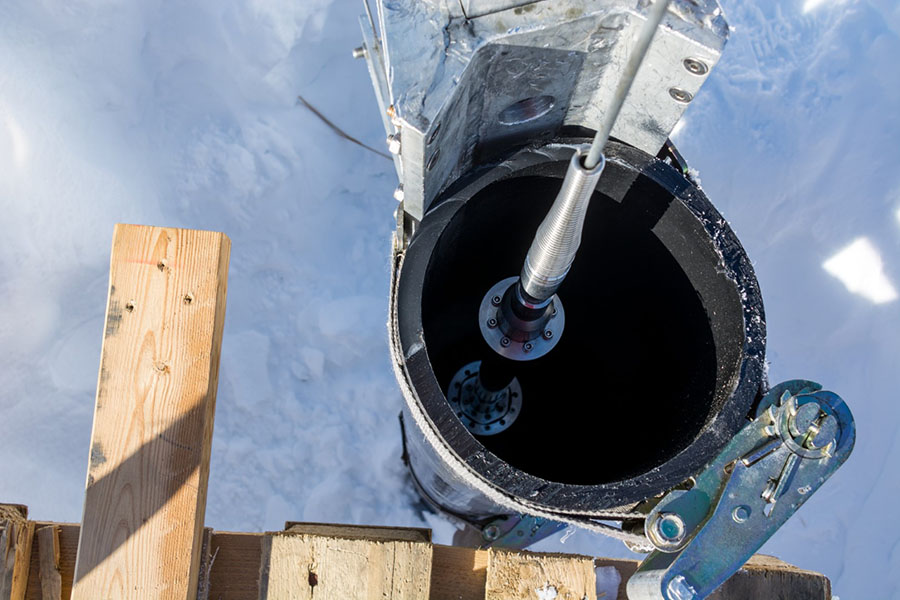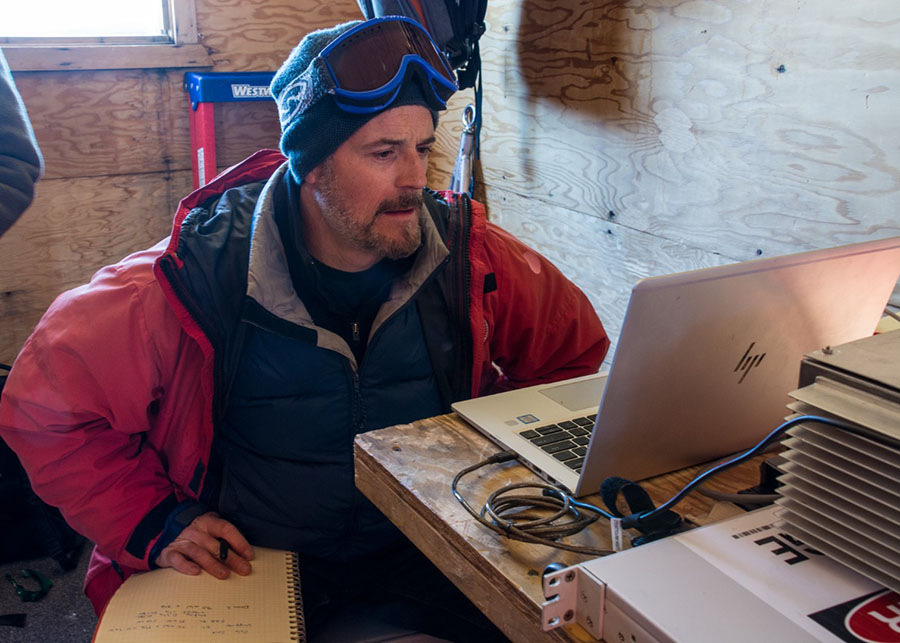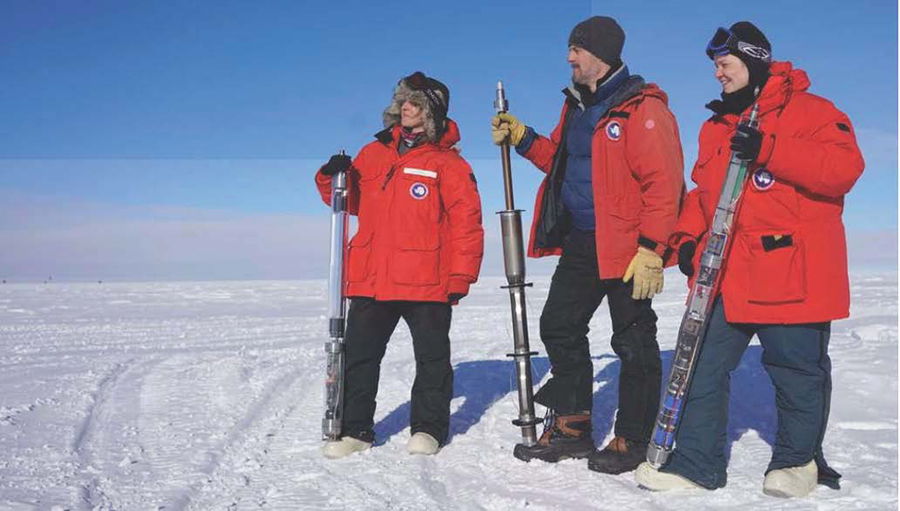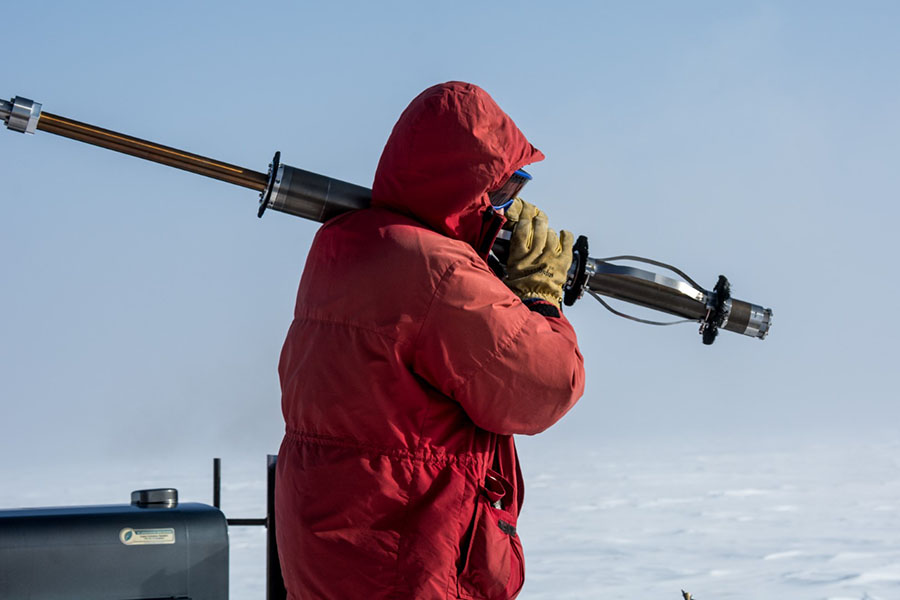Lights in the DarknessScientists Recycle an Ice Hole to See how Light Propagates Where the Sun Doesn't ShinePosted April 27, 2020
Scientists at the South Pole have been shining bright lights into buried ice to better hunt for exotic particles. Ice is the key ingredient to the IceCube neutrino detector. It's both what creates the Cherenkov radiation, the flashes of blue light that signifies a neutrino, and the medium that carries that emission to the light detectors. Understanding how it produces different kinds of light and how that light behaves within it is critical to extracting as much data as possible out of the massive experiment. Though the ongoing upgrade to IceCube will contain instruments to help characterize the clarity of the ice, a number of scientists looking to potential future IceCube upgrades don't want to wait. Over the last two years, they deployed multiple instruments down a nearby borehole to see how light shines through the frozen darkness. "We are studying subatomic particle interactions in the ice and we want to know, when we measure a certain amount of light, what the energy of the original particle was that created this cascade of light," said Ryan Bay, a physicist formerly at the University of California, Berkeley, now with a private startup company. "We want to better understand how light is generated in the ice and how that depends on impurities and temperature and other things." To access the icy depths, the researchers are using the open shaft leftover from the SpiceCore ice drilling project, which lasted from 2014 to 2016. That project collected ice cores as deep as 1,750 meters, stretching as far back as 50,000 years. After the project wrapped up, the hole that it left behind offered scientists the perfect opportunity to get a head start in understanding more about the ice that IceCube is embedded in. "What SpiceCore gives us is an open borehole, a working observatory that we can use again and again to put any instrument that we come up with into the ice to better understand the ice here," Bay said. Over two years, members of the IceCube team lowered three different instruments down the borehole to better characterize the optical aspects of the ice. 
Photo Credit: Mike Lucibella
A data logger gets lowered down into the SpiceCore borehole which extends 1,750 meters down into the ice at the South Pole.
"They're related for the purposes of IceCube," Bay said. "They're all about better understanding the impurities of the ice, the natural properties of the ice, how light is generated in the ice and how light propagates in the ice." Bay's instrument is a dust logger, designed to observe thin layers of dust and other particulates using a laser. "What the dust logger does is it's basically a camera it shines a laser directly sideways out into the ice and measures how much light comes back," Bay said. "The ice is extremely pure and ultraviolet light and visual light go very far, many tens of meters. The main thing that stops it is dust, it scatters off dust, it absorbs onto dust." The logger is performing double duty. Measuring the layers of dust can tell the history of Antarctica as told through layers of volcanic ash, dirt and clay. The ice in IceCube reaches back more than 100,000 years. The logger can also tell the astronomers a great deal about how the light from a neutrino's Cherenkov radiation can get disrupted and dissipated by ice impurities. "IceCube covers a cubic kilometer of ice, and throughout that ice, the dust layers do some pretty dramatic things," Bay said. "The dust layers tilt as much as 100 meters from one side of IceCube to another. So it’s not like we can just do it once and translate that all over IceCube, we really need to map the whole three-dimensional structure of IceCube." 
Photo Credit: Mike Lucibella
Anna Pollman (top) and Summer Blot adjust their instruments inside the small warming shack next to the borehole as one of their data loggers is lowered down.
Summer Blot, a physicist at DESY in Berlin, was operating her own data logger down the SpiceCore hole. Her instrument contained an LED that emitted ultraviolet light, an energetic wavelength that is beyond humans' ability to see with their naked eye. "It’s basically to measure how far the ultraviolet light can go before it scatters," Blot said. "What we're interested in is how well ultraviolet light travels in the ice; what's the attenuation length of ultraviolet light." The hope is that by having a better idea of how well ultraviolet light transmits through the deep glacial ice, future additions to IceCube might be able to incorporate ultraviolet detectors, in addition to ones that register blue light, in order to capture more information about neutrinos. "When a particle is producing Cherenkov radiation, most of the photons are in the ultraviolet range," Blot said. "For the same energy interaction you would get more light on your detector. And more light means higher statistics [which] means more accuracy." Anna Pollmann, a scientist at the University of Wuppertal in Germany, is investigating a different kind of light that's generated in the ice by an entirely different mechanism, a process called luminescence. 
Photo Credit: Mike Lucibella
Ryan Bay monitors the data coming back from the luminescence logger as it descents hundreds of meters below the surface of the ice.
"I want to measure how the ice here is lighting up when I radiate it with a radioactive source," Pollmann said. "That's something which very few people look into and it might be very interesting to use this kind of light in IceCube." Luminescence is a kind of light emission that occurs when an incoming particle energizes an atom it collides with. After a brief time, that atom returns to its normal ground state and reemits that energy as a signature glow. By investigating how the ice luminesces, it's possible to broaden what IceCube can detect for fundamental physics. Instead of just neutrinos, she's hoping that it might be able to find something entirely different. "What we also do in IceCube is we search for particles that nobody has seen before," Pollmann said. "If they exist, they would be easily visible with luminescence light but not with Cherenkov light. So at the moment we assume that IceCube is blind to them. But if we confirm what we already see in the lab, that we get a lot of photons off this luminescence light, then we can actually look for completely different types of particles." NSF-funded research in this story: Francis Halzen, University of Wisconsin, Madison, Award No. 1600823. |



For USAP Participants |
For The Public |
For Researchers and EducatorsContact UsU.S. National Science FoundationOffice of Polar Programs Geosciences Directorate 2415 Eisenhower Avenue, Suite W7100 Alexandria, VA 22314 Sign up for the NSF Office of Polar Programs newsletter and events. Feedback Form |



